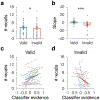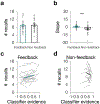Neurofeedback helps to reveal a relationship between context reinstatement and memory retrieval
- PMID: 31201985
- PMCID: PMC7034791
- DOI: 10.1016/j.neuroimage.2019.06.001
Neurofeedback helps to reveal a relationship between context reinstatement and memory retrieval
Abstract
Theories of mental context and memory posit that successful mental context reinstatement enables better retrieval of memories from the same context, at the expense of memories from other contexts. To test this hypothesis, we had participants study lists of words, interleaved with task-irrelevant images from one category (e.g., scenes). Following encoding, participants were cued to mentally reinstate the context associated with a particular list, by thinking about the images that had appeared between the words. We measured context reinstatement by applying multivariate pattern classifiers to fMRI, and related this to performance on a free recall test that followed immediately afterwards. To increase sensitivity, we used a closed-loop neurofeedback procedure, whereby higher classifier evidence for the cued category elicited increased visibility of the images from the studied context onscreen. Our goal was to create a positive feedback loop that amplified small fluctuations in mental context reinstatement, making it easier to experimentally detect a relationship between context reinstatement and recall. As predicted, we found that greater amounts of classifier evidence were associated with better recall of words from the reinstated context, and worse recall of words from a different context. In a second experiment, we assessed the role of neurofeedback in identifying this brain-behavior relationship by presenting context images again and manipulating whether their visibility depended on classifier evidence. When neurofeedback was removed, the relationship between classifier evidence and memory retrieval disappeared. Together, these findings demonstrate a clear effect of context reinstatement on memory recall and suggest that neurofeedback can be a useful tool for characterizing brain-behavior relationships.
Keywords: Free recall; Long-term memory; Real-time fMRI.
Copyright © 2019 Elsevier Inc. All rights reserved.
Figures





Similar articles
-
Mental reinstatement of encoding context improves episodic remembering.Cortex. 2017 Sep;94:15-26. doi: 10.1016/j.cortex.2017.06.007. Epub 2017 Jun 24. Cortex. 2017. PMID: 28710908
-
Transformed Neural Pattern Reinstatement during Episodic Memory Retrieval.J Neurosci. 2017 Mar 15;37(11):2986-2998. doi: 10.1523/JNEUROSCI.2324-16.2017. Epub 2017 Feb 15. J Neurosci. 2017. PMID: 28202612 Free PMC article.
-
Alpha-band oscillations track the retrieval of precise spatial representations from long-term memory.J Neurophysiol. 2019 Aug 1;122(2):539-551. doi: 10.1152/jn.00268.2019. Epub 2019 Jun 12. J Neurophysiol. 2019. PMID: 31188708 Free PMC article.
-
Sharpening Working Memory With Real-Time Electrophysiological Brain Signals: Which Neurofeedback Paradigms Work?Front Aging Neurosci. 2022 Mar 28;14:780817. doi: 10.3389/fnagi.2022.780817. eCollection 2022. Front Aging Neurosci. 2022. PMID: 35418848 Free PMC article. Review.
-
Stress and long-term memory retrieval: a systematic review.Trends Psychiatry Psychother. 2020 Jul-Sep;42(3):284-291. doi: 10.1590/2237-6089-2019-0077. Trends Psychiatry Psychother. 2020. PMID: 33084805 Free PMC article.
Cited by
-
INDUCING REPRESENTATIONAL CHANGE IN THE HIPPOCAMPUS THROUGH REAL-TIME NEUROFEEDBACK.bioRxiv [Preprint]. 2023 Dec 4:2023.12.01.569487. doi: 10.1101/2023.12.01.569487. bioRxiv. 2023. Update in: Philos Trans R Soc Lond B Biol Sci. 2024 Dec 2;379(1915):20230091. doi: 10.1098/rstb.2023.0091. PMID: 38106228 Free PMC article. Updated. Preprint.
-
A simulation-based approach to improve decoded neurofeedback performance.Neuroimage. 2019 Jul 15;195:300-310. doi: 10.1016/j.neuroimage.2019.03.062. Epub 2019 Apr 4. Neuroimage. 2019. PMID: 30954707 Free PMC article.
-
Influences on memory for naturalistic visual episodes: sleep, familiarity, and traits differentially affect forms of recall.Learn Mem. 2020 Jun 15;27(7):284-291. doi: 10.1101/lm.051300.119. Print 2020 Jul. Learn Mem. 2020. PMID: 32540918 Free PMC article.
-
Decoding context memories for threat in large-scale neural networks.Cereb Cortex. 2024 Jan 31;34(2):bhae018. doi: 10.1093/cercor/bhae018. Cereb Cortex. 2024. PMID: 38300181 Free PMC article.
-
Inducing representational change in the hippocampus through real-time neurofeedback.Philos Trans R Soc Lond B Biol Sci. 2024 Dec 2;379(1915):20230091. doi: 10.1098/rstb.2023.0091. Epub 2024 Oct 21. Philos Trans R Soc Lond B Biol Sci. 2024. PMID: 39428880 Free PMC article.
References
-
- Brainard DH, 1997. The psychophysics toolbox. Spat. Vis. 10, 433–436. - PubMed
Publication types
MeSH terms
Grants and funding
LinkOut - more resources
Full Text Sources
Research Materials

